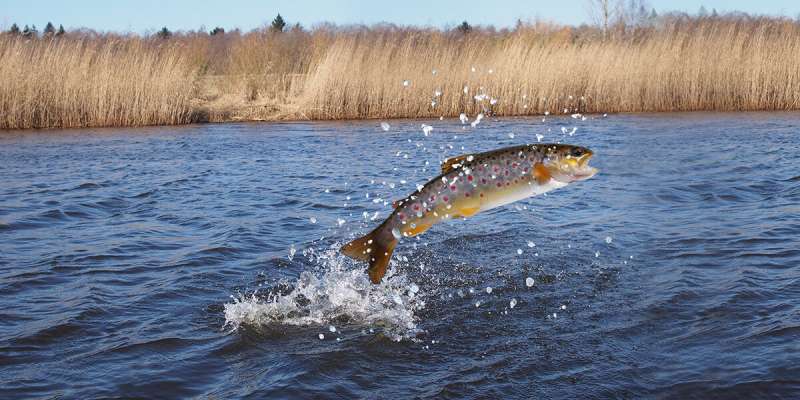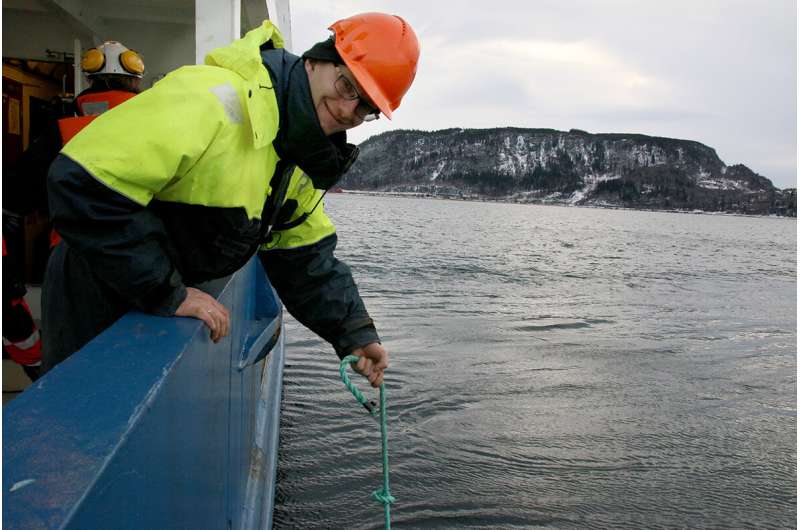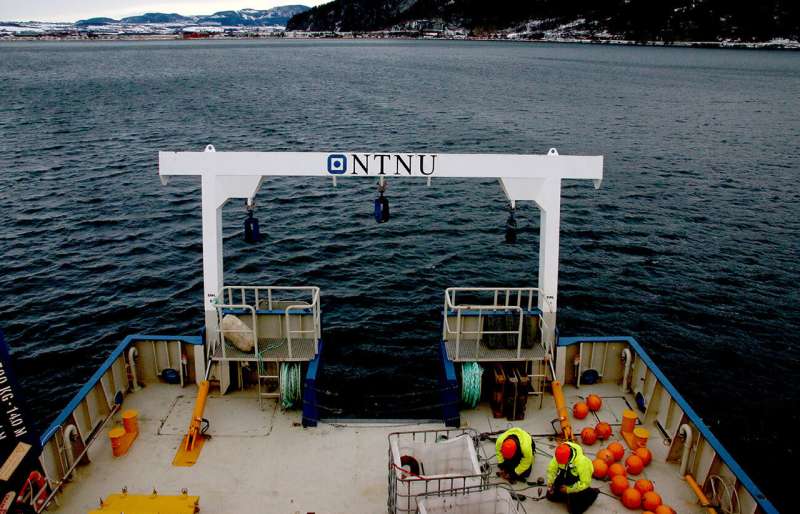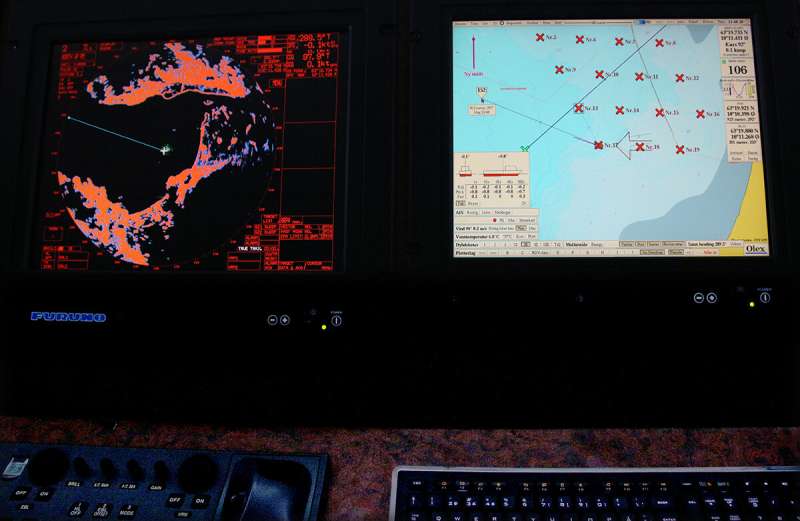This sea trout thrives in fresh water. In Norway, trout were released into mountain waters already in the Viking Age. Over the centuries, fish have been moved from low-lying waters and streams into higher-lying waters. This was done to provide food for the people on their farms and summer pastures. Credit: NTB scanpix
Sea trout populations have declined sharply. Researchers have studied the life of sea trout by means of acoustic telemetry tags and listening stations. Now they know more about what we need to do to protect the sea trout population.
"Salmon have received a lot of attention by Norwegian researchers. But sea trout haven't been studied as much. We know a lot less about the sea trout's migration to the ocean to feed, or how human activity in the coastal zone affects this migration," says researcher Jan Grimsrud Davidsen.
In 2011, Davidsen decided to do something about the lack of knowledge about sea trout migrations. He and several researchers from NTNU started a project that has now mapped and followed the trout's life cycle in a number of Norwegian fjords and rivers.
"The sea trout is a species that lives in coastal waters and in associated fresh water systems, and it's very susceptible to human activity. That's why we believe it's important to know more about what these fish do, especially when they're out at sea," says Davidsen, a researcher in the Department of Natural History at the NTNU University Museum.
"Sea trout populations in Norway are struggling, and only 20 percent are classified as being in good or very good condition. The most critical situations are in western Norway and central Norway," he says.
Live completely different lives
Trout are peculiar. They all start their lives in pretty much the same way, but then individual trout develop very differently as they mature.
Why this happens is still unclear. But researchers are working on the question.
All trout start life in fresh water. Sexually mature trout spawn in streams and rivers during the fall and winter. In spring, the eggs hatch and the trout fry live in fresh water until they are between one and four years old. During this period they are relatively dark in color and have black and red spots along their sides. This serves as camouflage.
Some trout then undergo a physiological adaptation to tolerate salt water (smoltification) and are called smolt. In these individuals, their behavior changes—and they start their journey out to sea. The smolt transform from being territorial and aggressive to becoming schooling fish that migrate with the current towards the mouth of the river or creek.
Sea trout populations in Norway are struggling, and only 20 per cent of them are classified as being in good or very good condition. Western Norway and central Norway populations are in the worst shape. Credit: Sindre Håvarstein Eldøy
Migrate between salt water and fresh water
The smolt takes on a more elongated shape than its non-migratory kin, and turns a shimmery silver color when it arrives at sea. Now the smolt has become a sea trout.
Later it will return to fresh water at regular intervals. This migration between salt water and fresh water classifies it as an anadromous fish.
Trout that don't become smolt stay in their home waters, behave aggressively and swim against the current. They live in fresh water throughout their lives and eventually become brown trout.
"There's enormous variation in how the trout develops and lives. It leads a complicated life that we're now beginning to understand a bit better," says Davidsen.
More food in the ocean
The seaward migration usually happens in the springtime. Some trout migrate all the way out to sea, where they have much better access to food than in streams and rivers. This is where they feed and grow larger.
From July onwards the trout returns to fresh water (rivers, streams and lakes) where it overwinters and may spawn if it is mature.
Then it becomes ocean bound again when spring arrives.
The estuary, where the river opens into the sea, is the sea trout's first encounter with salt water. Many individuals remain in the estuary throughout their time in salt water.
Other individuals venture further out to sea on their migration. Paradoxically, these are often less robust fish in poorer condition. A preponderance of female fish are also among those that travel the farthest out to sea to find food.
"The first few years we mapped what the sea trout does when it's out in the fjord. Then we started to study why it behaves the way it does," says Jan Davidsen.
Researcher Jan Grimsrud Davidsen lowers an automatic listening station that receives minute-by-minute signals from the tagged sea trout passing by. Credit: Idun Haugan / NTNU
Female fish take the greatest risk
Sea trout migrate to the sea for better access to prey.
"The females have the most to gain from going out into the fjord and along the coast to feed on pelagic fish, shrimp and krill. This environment allows them to grow bigger and increase their production of roe. Or they become better able to fight for a redd (spawning ground), thereby increasing the possibility of reproductive success. So the females are more willing to take this risk than male fish," he says.
Migrating to the ocean has its costs, such as greater energy demands, the risk of not finding the way back to the river, being eaten along the way or becoming infected with disease, salmon lice and other parasites.
"Also, fish with low nutritional reserves in the spring have to take more chances so they can bulk up. These conditions make them more willing to swim to sea and migrate greater distances to find sustenance. We can say that a fat male fish is typically more of a homebody and often stays in the mouth of the river and close to its home river," says Davidsen.
What do fish do in the estuary?
One of the sub-projects has been to follow the trout's movements in the Gaulosen estuary outside Trondheim where Norway's top salmon river, the Gaula River, flows into the sea. River deltas are places where sea trout thrive.
"We started a project in the Gaulosen estuary where we've been working in a very detailed way to map exactly how sea trout use the estuary," says Davidsen.
Norway's river estuaries are under severe pressure.
"River estuaries are important for sea trout, and they're an endangered habitat type. Many estuaries are located in larger cities and have been developed for different purposes. The outlet of Nidelva in Trondheim is an example of a river that has been completely destroyed. The mouth of the Stjørdal River by Trondheim Airport is another example.
But the Gaulosen is still quite undisturbed, so here researchers are able to gather background data on how undeveloped areas work for marine organisms like sea trout.
NTNU’s research vessel the R/V Gunnerus has been important for the sea trout survey. In this photo, Gunnerus drops listening stations outside Gaulosen. Credit: Idun Haugan / NTNU
Following sea trout movements
In the winter of 2018, researchers lowered automatic "listening stations" into the Gaulosen waters. They fitted 40 mature sea trout with acoustic sensors and electronic ID tags. Once a minute, the sensor in the fish transmitted information to the listening stations, which recorded which fish swam past and at what depth they were swimming.
"This setup is how we've been able to follow the trout's life minute by minute over several months," says Davidsen.
For three years, scientists have been monitoring the movements of sea trout using the listening stations. They've collected four to five million records from sea trout that pass through the area.
"It seems that Gaulosen is a winter vacation resort for sea trout. Undisturbed marine estuaries offering good nutritional access are important habitats for sea trout, especially in the winter and early spring," says Davidsen.
Sandy estuary bottoms are a favorite habitat for the bristle worm (class Polychaeta), which is one of the sea trout's preferred meals.
"Some sea trout stay here for almost the entire year, so they're especially vulnerable when the river estuaries are being eroded," Davidsen says.
Pernicious salmon lice
Salmon lice have contributed to the decline in the sea trout population. Although salmon lice are not that common in the Trondheim Fjord, the researchers found clear signs of lice on sea trout when they conducted a survey farther north in Nordland county.
Just before the end of last year, the researchers completed a four-year mapping project on marine migrations and area use for sea trout and Arctic char in the Skjerstad Fjord in Nordland.
Their research included studying the salmon lice problem.
Measuring instruments aboard the research vessel Gunnerus show where the listening stations have been lowered. Credit: Idun Haugan / NTNU
Individual sea trout that migrate far out in the fjord instead of staying in the river estuary are at greatest risk of coming into contact with fish farms and their associated salmon lice. And in spite of their name, salmon lice can feed on sea trout.
Many types of fish, such as cod and saithe, congregate around fish farms because of the easy access to food there. Close contact with the farmed fish makes the wild fish more susceptible to lice.
One of the main findings in the Skjerstad Fjord is that sea trout and Arctic char actually do not spend much time around the farm sites. The researchers have mapped their travels using listening stations at select locations in the fjord, including around fish farms.
And yet the findings confirmed that sea trout have nonetheless come into close contact with salmon lice. The researchers collected data from a fishing trap installed in Lake Botnvatnet, which registered fish as they migrated from the fjord up into the river.
Of the 1476 sea trout that were recorded, fully 75 percent had salmon lice wounds. Forty-four percent were recorded with one to ten attached adult lice, and nine percent had more than ten lice.
New and unique understanding
In addition to following the fish migrations through the fish data picked up by the listening stations, the researchers also caught sea trout in fjords and rivers and analyzed their stomach contents.
These research methods "are giving us a whole new and unique understanding of the life of sea trout during their marine nutrient migration," says Davidsen. "We're getting a better idea of the threat factors sea trout face by finding out how they live in the fjord. That in turn contributes to devising a more efficient management strategy."
If various threats cause sea trout to stop migrating to the ocean where they can find ample food and grow well, this could significantly alter the trout's development and weaken the population.
"As researchers, our mission is to share facts and knowledge. Then it's up to the politicians to weigh the environmental considerations against economic value creation and socially beneficial purposes," says Davidsen.
"We consider it really important to involve all the stakeholder groups in research where there are conflicting interests, and where the research is quickly used by management and in political decision-making processes. So from the outset, a basic principle of our projects has been to share the financing as much as possible among teams from industry, the administration and local landowner groups," he says.
More information: Xavier Bordeleau et al. Nutritional correlates of spatiotemporal variations in the marine habitat use of brown trout (Salmo trutta) veteran migrants, Canadian Journal of Fisheries and Aquatic Sciences (2018). DOI: 10.1139/cjfas-2017-0350
Yajie Liu et al. Social-Cultural Ecosystem Services of Sea Trout Recreational Fishing in Norway, Frontiers in Marine Science (2019). DOI: 10.3389/fmars.2019.00178
Sindre H. Eldøy et al. Individual Repeatability in Marine Migratory Behavior: A Multi-Population Assessment of Anadromous Brown Trout Tracked Through Consecutive Feeding Migrations, Frontiers in Ecology and Evolution (2019). DOI: 10.3389/fevo.2019.00420
Journal information: Canadian Journal of Fisheries and Aquatic Sciences
Provided by Norwegian University of Science and Technology


























